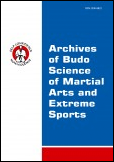2018, Volume 14, Issue 1
Multidimensional tests as a fundamental diagnostic tools in the prophylactic and therapeutic agonology – methodological basis of personal safety (Part II: motor and psychomotor multidimensional tests)
Roman Maciej Kalina1
1Department of Combat Sport, Gdansk University of Physical Education and Sport, Gdansk, Poland
Author for correspondence: Roman Maciej Kalina; Department of Combat Sport, Gdansk University of Physical Education and Sport, Gdansk, Poland; email: kom.kalina@op.pl
Full text
Abstract
Background & Study Aim: The author in “Part I: non-motoric simulation” defines two types of multidimensional tests (motor and psychomotor) and also simulation (simulation studies) distinguishing motor (psychomotoric) simulations and non-motor simulation. These tests and simulations apply in a positive health and ability to survived diagnosis. The aim of this study is scientific argumentation create multidimensional tests for the diagnosis of positive health and ability to survive in the universal sense.
Material & Methods: Secondary analysis of the results obtained while studying the multidimensional military specific test (MMST-10) comprises 10 tasks (motor and psychomotor) performed at a distance of 3 km of simulated attack. Each task is assessed individually in terms of its effectiveness using scores according to the T scale (from 1 to 100 points). Points are assigned depending on the time needed to perform the task. The assessment of tasks 1, 2, 5, 9 and 10 may be supplemented with relevant information. Time remains the only criterion for the effectiveness of tasks: 4, 6, 7, 8.
Polish military cadets (34 experimental group, 36 control group), who began their studies in academic year 1979/1980 (there were two hostile political and military systems during this period, and terrorism was common). Average age cadets from experimental group 20.41 years, control group 20.55 years. Cadets during the first 8 months of military training four times done a MMST-10.
Results: The actual multidimensional effect of modern military training was reflected by the MMST-10 results achieved after 46 weeks. The only difference which was not statistically significant was the one between the results of task 2 and 9 (throwing a grenade to a facade window). Nearly equal coefficients of partial correlation (r = 0.953; 0.987 and −0.900) between an overall results of the MMST-10 and its constituents indicates that the quality of military tasks performed at a distance of 3,000 m and the duration of the test have identical impact on the quality of military tasks performed.
Conclusions: Associating the results of multidimensional tests in the category of motor or psychomotor simulation with results of simulation research supported by modern technology, but first of all with results of non-motor simulation creates the basis for determining the criteria for safe estimation of survival ability exhibited by persons with a certain probability of complete feasibility of action in given category of threat to life or health.
Key words: possibility of action, positive health, motor competence, praxeology, survival ability, terrorism





